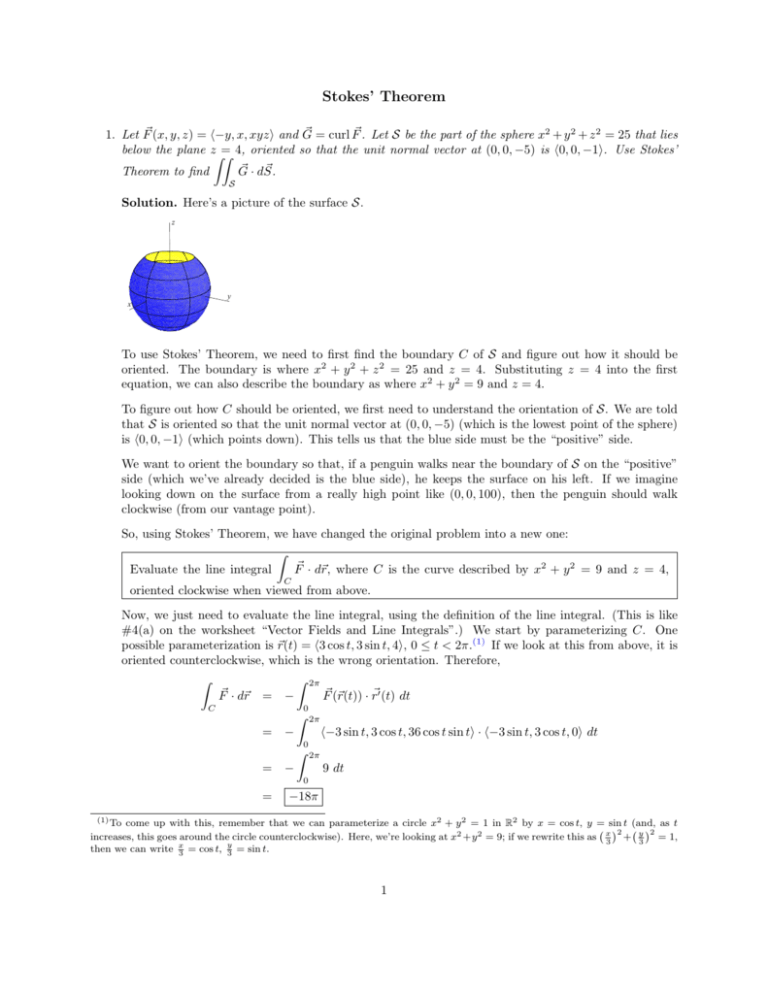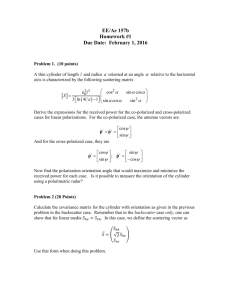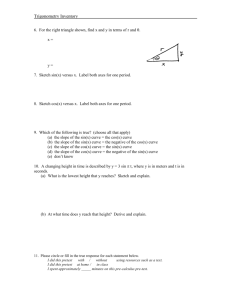Stokes' Theorem
advertisement

Stokes’ Theorem ~ = curl F~ . Let S be the part of the sphere x2 + y 2 + z 2 = 25 that lies 1. Let F~ (x, y, z) = h−y, x, xyzi and G below the plane zZ = Z 4, oriented so that the unit normal vector at (0, 0, −5) is h0, 0, −1i. Use Stokes’ ~ · dS. ~ Theorem to find G S Solution. Here’s a picture of the surface S. z y x To use Stokes’ Theorem, we need to first find the boundary C of S and figure out how it should be oriented. The boundary is where x2 + y 2 + z 2 = 25 and z = 4. Substituting z = 4 into the first equation, we can also describe the boundary as where x2 + y 2 = 9 and z = 4. To figure out how C should be oriented, we first need to understand the orientation of S. We are told that S is oriented so that the unit normal vector at (0, 0, −5) (which is the lowest point of the sphere) is h0, 0, −1i (which points down). This tells us that the blue side must be the “positive” side. We want to orient the boundary so that, if a penguin walks near the boundary of S on the “positive” side (which we’ve already decided is the blue side), he keeps the surface on his left. If we imagine looking down on the surface from a really high point like (0, 0, 100), then the penguin should walk clockwise (from our vantage point). So, using Stokes’ Theorem, we have changed the original problem into a new one: Z F~ · d~r, where C is the curve described by x2 + y 2 = 9 and z = 4, Evaluate the line integral C oriented clockwise when viewed from above. Now, we just need to evaluate the line integral, using the definition of the line integral. (This is like #4(a) on the worksheet “Vector Fields and Line Integrals”.) We start by parameterizing C. One possible parameterization is ~r(t) = h3 cos t, 3 sin t, 4i, 0 ≤ t < 2π.(1) If we look at this from above, it is oriented counterclockwise, which is the wrong orientation. Therefore, Z Z 2π F~ · d~r = − F~ (~r(t)) · r~0 (t) dt C 0 Z = 2π − h−3 sin t, 3 cos t, 36 cos t sin ti · h−3 sin t, 3 cos t, 0i dt 0 Z = 2π − 9 dt 0 = −18π (1) To come up with this, remember that we can parameterize a circle x2 + y 2 = 1 in R2 by x = cos t, y = sin t (and, as t 2 2 increases, this goes around the circle counterclockwise). Here, we’re looking at x2 +y 2 = 9; if we rewrite this as x3 + y3 = 1, y then we can write x3 = cos t, 3 = sin t. 1 2 2. Let F~ (x, y, z) = h−y, x, zi. Let S be the part of the paraboloid z = 7 − x2 − 4yZ Zthat lies above the plane ~ z = 3, oriented with upward pointing normals. Use Stokes’ Theorem to find curl F~ · dS. S Solution. Here is a picture of the surface S. z y x The strategy is exactly the same as in #1. The boundary is where z = 7 − x2 − 4y 2 and z = 3, which is the same as x2 + 4y 2 = 4 and z = 3. Since S is oriented with normals pointing upward, the top side of the paraboloid (the yellow side in the picture) is the “positive” side. If we imagine looking down on the surface from above, then a penguin walking around on the “positive” (yellow, in this case) side keeps the surface on his left by walking counterclockwise. Therefore, by Stokes’ Theorem, the original problem can be rewritten as Z Evaluate the line integral F~ · d~r, where C is the curve described by x2 + 4y 2 = 4 and z = 3, C oriented counterclockwise when viewed from above. A parameterization of this curve is ~r(t) = h2 cos t, sin t, 3i.(2) This goes counterclockwise when viewed from above (as we want), so Z 2π Z F~ (~r(t)) · ~r0 (t) dt F~ · d~r = C 0 Z 2π h− sin t, 2 cos t, 3i · h−2 sin t, cos t, 0i dt = 0 Z 2π (2 sin2 t + 2 cos2 t) dt = 0 Z 2π = 2 dt 0 = 4π 2 come up with this parameterization, rewrite x2 + 4y 2 = 4 as x2 + y 2 = 1 and then use x2 = cos t, y = sin t. It’s easy to check that it’s reasonable: if we plug in x = 2 cos t, y = sin t, and z = 3, then the equations x2 + 4y 2 = 4 and z = 3 are indeed satisfied. (2) To 2 3. The plane z = x + 4 and the cylinder x2 + y 2 = 4 intersect in a curve C. Suppose C is oriented 3 2 ~ counterclockwise Z when viewed from above. Let F (x, y, z) = hx + 2y, sin y + z, x + sin z i. Evaluate the line integral F~ · d~r. C Solution. We’ll use Stokes’ Theorem. To do this, we need to think of an oriented surface S whose (oriented) boundary is C (that is, we need to think of a surface S and Z Z Z orient it so that the given ~ Let’s compute orientation of C matches). Then, Stokes’ Theorem says that F~ · d~r = curl F~ · dS. C S curl F~ first. (It’s worthwhile to do this first because, if we find out it’s ~0, then we know the integral will be 0 without any more work.) In this case, curl F~ = h−1, −1, −2i. Now, let’s think of a surface whose boundary is the given curve C. We are told that C is the intersection of a plane and a cylinder (left picture), so one surface we could use is the part of the plane inside the cylinder (right picture): z z y x y x Let’s call this S and figure out how it should be oriented. We want to orient S so that, if a penguin walks along the given curve C (going counterclockwise when viewed from above) on the “positive” side of S, he keeps the surface on his left. This means that we want the top side of S to be the “positive” side, so we should orient S with normals pointing upward. So, using Stokes’ Theorem, we have changed the original problem into a new one: ZZ ~ · dS, ~ where S is the part of the plane z = x + 4 inside the Evaluate the flux integral G S ~ is the vector field G(x, ~ cylinder x2 + y 2 = 4, oriented with normals pointing upward, and G y, z) = h−1, −1, −2i. To do this new problem, let’s follow the same three steps we used in #4(a) on the worksheet “Flux Integrals”. First, we parameterize S. Since the plane has equation z = x+4, we can use x and y as our parameters. If we let x = u and y = v, then z = u + 4. This gives the parameterization ~r(u, v) = hu, v, u + 4i. Since we are only interested in the part of the plane inside the cylinder x2 + y 2 = 4, we want x2 + y 2 < 4. In terms of u and v, this says u2 + v 2 < 4, so the region R in the uv-plane describing the possible parameter values is a disk: 3 v 2 R 2 -2 u -2 Next, we need to see what orientation this parameterization describes. To do this, we compute ~ru ×~rv : ~ru = h1, 0, 1i ~rv = h0, 1, 0i ~ru × ~rv = h−1, 0, 1i This always points upward, which matches the orientation we want. So, the flux integral is ZZ ZZ ~ · dS ~ = ~ r(u, v)) · (~ru × ~rv ) dA G G(~ S Z ZR = h−1, −1, −2i · h−1, 0, 1i dA Z ZR = −1 dA R Although we could evaluate this Z Zdouble integral by converting it to an iterated integral, there is an easier way — remember that 1 dA gives the area of R (see #2(a) on the worksheet “Double R Integrals”). Therefore, ZZ ZZ ~ · dS ~ G = − 1 dA R S = −(area of R) = −4π 4. Let C be the oriented curve parameterized by ~r(t) = hcos t, sin t, 8 − cos2Zt − sin ti, 0 ≤ t < 2π, and let D E √ F~ be the vector field F~ (x, y, z) = z 2 − y 2 , −2xy 2 , e z cos z . Evaluate F~ · d~r. C Solution. The line integral is very difficult to compute directly, so we’ll use Stokes’ Theorem. The curl of the given vector field F~ is curl F~ = h0, 2z, 2y − 2y 2 i. To use Stokes’ Theorem, we need to think of a surface whose boundary is the given curve C. First, let’s try to understand C a little better. We are given a parameterization ~r(t) of C. In this parameterization, x = cos t, y = sin t, and z = 8 − cos2 t − sin t. So, we can see that x2 + y 2 = 1 and z = 8 − x2 − y. In other words, C must be the intersection of the surface x2 + y 2 = 1 (which is a cylinder) and the surface z = 8 − x2 − y (which we don’t need to visualize particularly well, beyond noticing that it’s the graph of a function f (x, y) = 8 − x2 − y). So, one surface we could use is the part of the surface z = 8 − x2 − y inside the cylinder x2 + y 2 = 1 (right picture). 4 z z y x y x Let’s call this surface S and figure out how it should be oriented. The original curve was parameterized using x = cos t, y = sin t, so when viewed from above, it was oriented counterclockwise. Therefore, we want to orient S so that is top is the “positive” side (a penguin walking on the top along the boundary, going counterclockwise when viewed from above, keeps the surface on his left). So, we should orient S with normals pointing upward. So, using Stokes’ Theorem, we have changed the original problem into a new one: ZZ ~ · dS, ~ where S is the part of the surface z = 8 − x2 − y inside the G Evaluate the flux integral S ~ is the vector field G(x, ~ cylinder x2 + y 2 = 1, oriented with normals pointing upward, and G y, z) = 2 h0, 2z, 2y − 2y i. To do this new problem, let’s follow the same three steps we used in #4(a) on the worksheet “Flux Integrals”. First, we parameterize S. Since the surface has equation z = 8 − x2 − y, we can parameterize it as ~r(u, v) = hu, v, 8 − u2 − vi. Since we are only interested in the part of the surface inside the cylinder x2 + y 2 = 1, we want x2 + y 2 < 1; in terms of u and v, this says u2 + v 2 < 1, so the region R in the uv-plane describing the possible parameter values is a disk: v 1 R 1 -1 u -1 Next, we need to see what orientation this parameterization describes. To do this, we compute ~ru ×~rv : ~ru = h1, 0, −2ui ~rv = h0, 1, −1i ~ru × ~rv = h2u, 1, 1i This always points upward, which matches the orientation we want. So, the flux integral is ZZ ZZ ~ · dS ~ = ~ r(u, v)) · (~ru × ~rv ) dA G G(~ S R ZZ = h0, 2(8 − u2 − v), 2v − 2v 2 i · h2u, 1, 1i dA R ZZ = (16 − 2u2 − 2v 2 ) dA R 5 Since our region R is a disk, let’s do this integral in polar coordinates. The disk R can be described as 0 ≤ r < 1, 0 ≤ θ < 2π, so ZZ Z 2π Z 1 ~ ~ (16 − 2r2 ) · r dr dθ G · dS = S 0 0 2π Z = 2π = 0 = 0 = (16r − 2r3 ) dr dθ r=1 ! 1 8r2 − r4 dθ 2 r=0 2π Z 1 0 0 Z Z 15 dθ 2 15π 5. Let C be the curve of intersection of 2x2 + 2y 2 + z 2 = 9 with z = 1 2 p counterclockwise x2 + y 2 , oriented Z 3 2 when viewed from above, and let F~ (x, y, z) = h3y, 2yz, xz + sin z i. Evaluate F~ · d~r. C Solution. Again, we’ll use Stokes’ Theorem. The curl of the given vector field is curl F~ = −2y, −z 3 , −3 . We’ll start by thinking of an oriented surface S whose (oriented) boundary is the given curve C. The curve is the intersection of an ellipsoid with a cone: z y x It appears from the picture that the curve lies in a p plane parallel to the xy-plane. To verify this, let’s look at the equations 2x2 + 2y 2 + z 2 = 9 and z = 21 x2 + y 2 defining the curve. The second equation can be rewritten as x2 + y 2 = 4z 2 . Plugging this into the first equation, 9z 2 = 9, so z = ±1. Since the cone is only defined for z ≥ 0, we know the intersection is where z = 1, in which case x2 + y 2 = 4. There are many surfaces whose boundary is the given curve C. From what we know so far, there are several surfaces that might come to mind: 6 z z y z y x x The part of the cone inside the ellipsoid. z y x The part of the ellipsoid lying above the curve. The part of the ellipsoid lying below the curve. y x The part of the plane z = 1 lying inside x2 + y 2 = 4. Each of these should be oriented so that the yellow side is the “positive” side. The last is probably the simplest, so let’s use that. To have the yellow side be the “positive” side, we want the normals to point upward. Thus, we have rewritten the original problem as: ZZ ~ · dS, ~ where S is the part of the plane z = 1 lying inside x2 + y 2 = 4, Evaluate the flux integral G S ~ is the vector field G(x, ~ oriented with normals pointing upward, and G y, z) = −2y, −z 3 , −3 . To do this, we first parameterize the surface. Since it is part of the plane z = 1, we can parameterize it by ~r(u, v) = hu, v, 1i. Since we want only the part inside x2 + y 2 = 4, the region R in the uv-plane describing the possible parameter values is the disk u2 + v 2 < 4: v 2 R 2 -2 u -2 Next, we see what orientation this parameterization describes. To do this, we compute ~ru × ~rv : ~ru = h1, 0, 0i ~rv = h0, 1, 0i ~ru × ~rv = h0, 0, 1i This always points upward, so our parameterization matches the orientation we want. Therefore, the flux integral is ZZ ZZ ~ · dS ~ = ~ r(u, v)) · (~ru × ~rv ) dA G G(~ S R ZZ = h−2v, −1, −3i · h0, 0, 1i dA Z ZR = −3 dA R ZZ = −3 1 dA R = = −3(area of R) by the worksheet “Double Integrals”, #2(a) −12π 7 6. The two surfaces shown have the same boundary. Suppose they are both oriented so that the light side is the “positive” side. Is theZ Zfollowing reasoning Z Z correct? “Since S1 and S2 have the same (oriented) ~ ~ ~ · dS ~ must be equal for any vector field G. ~ Therefore, boundary, the flux integrals G · dS and G S1 S2 you can compute any flux integral using the simpler surface.” x S1 S2 z z y x y ~ is the curl of some other vector field, Solution. False. The statement is true if the vector field G ~ ~ say oriented) boundary, Stokes’ Theorem says that Z Z G = curl F . ZIn Z that case, if C is the (properly Z ~ ~ has to be the ~ ~ ~ ~ F · d~r. But there’s no reason that G G · dS and G · dS are both equal to S1 S1 C curl of some other vector field, so the statement is false in general. 8






